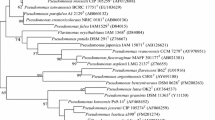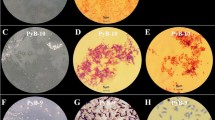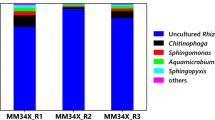Abstract
In the current study, the PL7 strain was isolated from soil and identified as Raoultella planticola based on its physiological characteristics and 16S rDNA sequence. By the 10th day, the PL7 strain degraded 52.0% of the pyrene (PYR) content and 50.8% of the benzo[a]pyrene (BaP) content in 20 mg L−1 PYR and 10 mg L−1 BaP in the liquid matrix. The half-life of PYR and BaP by PL7 degradation was 8.59 and 9.46 days, respectively. At pH 8.0, the degradation rates of PYR and BaP by PL7 were significantly higher at 30 °C than at 20 and 40 °C. The degradation ability of PL7 differed in red soil, paddy soil and fluvo-aquic soil; red soil produced the fastest degradation rates. The half-life of PYR and BaP by PL7 degradation in red soil was 21.7 and 11.9 days, respectively; however, without PL7 the half-life of PYR in red soil was 91.2 days. This study demonstrated the significant potential of the PL7 strain for bioremediation applications in the liquid matrix and soil contaminated by PAHs.






Similar content being viewed by others
References
Altschul SF, Madden TL, Schaffer AA, Zhang J, Zhang Z, Miller W (1997) Gapped BLAST and PSI-BLAST: a new generation of protein database search programs. Nucleic Acids Res 25:3389–3402
Arulazhagan P, Vasudevan N (2011) Biodegradation of polycyclic aromatic hydrocarbons by a halotolerant bacterial strain Ochrobactrum sp. VA1. Mar Pollut Bull 62:388–394
Chen B, Ding J (2012) Biosorption and biodegradation of phenanthrene and pyrene in sterilized and unsterilized soil slurry systems stimulated by Phanerochaete chrysosporium. J Hazard Mater 229:159–169
Chen M, Xu P, Zeng GM, Yang CP, Huang DL, Zhang JC (2015) Bioremediation of soils contaminated with polycyclic aromatic hydrocarbons, petroleum, pesticides, chlorophenols and heavy metals by composting: applications, microbes and future research needs. Biotechnol Adv 33:745–755
Contreras-Ramos SM, Álvarez-Bernal D, Dendooven L (2008) Removal of polycyclic aromatic hydrocarbons from soil amended with biosolid or vermicompost in the presence of earthworms (Eisenia foetida). Soil Biol Biochem 40:954–1959
Elgh-Dalgren K, Arwidsson Z, Ribé V, Waara S, Kronhelm TV, Patrick AW (2011) Bioremediation of a soil industrially contaminated by wood preservatives-degradation of polycyclic aromatic hydrocarbons and monitoring of coupled arsenic translocation. Water Air Soil Pollut 214(1):275–285
El-Mansi EMT, Bryce CFA, Demain AL, Allman AR (2007) Fermentation microbiology and biotechnology, 2nd edn. CRC Press, London, New York
Fetzer JC (2007) The chemistry and analysis of the large polycyclic aromatic hydrocarbons. Polycycl Aromat Compd 27:143–162
Fu B, Li QX, Xu T, Cui ZL, Sun Y, Li J (2014) Sphingobium sp. FB3 degrades a mixture of polycyclic aromatic hydrocarbons. Int Biodeterior Biodegrad 87:44–51
Ghoshal S, Ramaswami A, Luthy RG (1996) Biodegradation of naphthalene from coal tar and heptamethylnonane in mixed batch system. Environ Sci Technol 30:1282–1291
Kanaly RA, Harayama S (2000) Biodegradation of high-molecular-weight polycyclic aromatic hydrocarbons by bacteria. J Bacteriol 182:2059–2067
Kastner M, Breuer-Jammali M, Mahro B (1998) Impact of inoculation protocols, salinity, and pH on the degradation of polycyclic aromatic hydrocarbons (PAHs) and survival of PAH-degrading bacteria introduced into soil. Appl Environ Microbiol 64:359–362
Kumar V, Maitra SS (2016) Biodegradation of endocrine disruptor dibutyl phthalate (DBP) by a newly isolated Methylobacillus sp. V29b and the DBP degradation pathway. 3 Biotech 6:200
Liang L, Song XH, Kong J, Shen CH, Huang TW, Hu Z (2014) Anaerobic biodegradation of high-molecular-weight polycyclic aromatic hydrocarbons by a facultative anaerobe Pseudomonas sp. JP1. Biodegradation 25:825–833
Liu ZQ, Dong LZ, Cheng F, Xue YP, Wang YS, Ding JN, Zheng YG, Shen YC (2011) Gene cloning, expression, and characterization of a nitrilase from Alcaligenes faecalis ZJUTB10. J Agric Food Chem 62:11560–11570
Lors C, Damidot D, Ponge JF, Périé F (2012) Comparison of a bioremediation process of PAHs in a PAH-contaminated soil at field and laboratory scales. Environ Pollut 165:11–17
Luo YR, Tian Y, Huang X, Yan CL, Hong HS, Lin GH, Zheng T (2009) Analysis of community structure of a microbial consortium capable of degrading benzo(a)pyrene by DGGE. Mar Pollut Bull 58:1159–1163
Machín-Ramírez C, Morales D, Martínez-Morales F, Okoh AI, Trejo-Hernández MR (2010) Benzo[a]pyrene removal by axenic- and co-cultures of some bacterial and fungal strains. Int Biodeterior Biodegrad 64:538–544
Mao J, Luo YM, Teng Y, Li ZG (2012) Bioremediation of polycyclic aromatic hydrocarbon-contaminated soil by a bacterial consortium and associated microbial community changes. Int Biodeterior Biodegrad 70:141–147
Marusenko Y, Herckes P, Hall SJ (2011) Distribution of polycyclic aromatic hydrocarbons in soils of an arid urban ecosystem. Water Air Soil Pollut 219:473–487
Nacher-Mestre J, Serrano R, Portoles T, Berntssen MHG, Pérez Sánchez J, Hernández F (2014) Screening of pesticides and polycyclic aromatic hydrocarbons in feeds and fish tissues by gas chromatography coupled to high-resolution mass spectrometry using atmospheric pressure chemical ionization. J Agric Food Chem 62:2165–2174
Ortega-González DK, Martínez-González G, Flores CM, Zaragoza D, Cancino-Diaz JC, Cruz-Maya JA, Roblero JJ (2015) Amycolatopsis sp. Poz14 isolated from oil-contaminated soil degrades polycyclic aromatic hydrocarbons. Int Biodeterior Biodegrad 99:165–173
Ping LF, Zhang CR, Zhu YH, Wu M, Hu XQ, Li Z, Zhao H (2011) Biodegrading of pyrene by a newly isolated Pseudomonas putida PL2. Biotechnol Bioprocess Eng 16:1000–1008
Ping LF, Zhang CR, ZhangCP ZhuYH, He HM, Wu M, Tang T, Li Z, Zhao H (2014) Isolation and characterization of pyrene and benzo[a] pyrene-degrading Klebsiella pneumonia PL1 and its potential use in bioremediation. Appl Microbiol Biotechnol 98:3819–3828
Shi ZP, Tian L, Zhang YG (2010) Molecular biology approaches for understanding microbial polycyclic aromatic hydrocarbons (PAHs) degradation. Acta Ecol Sin 30:292–295
Song XH, Xu Y, Li GM, Zhang Y, Huang TW, Hu Z (2011) Isolation, characterization of Rhodococcus sp. P14 capable of degrading high-molecular-weight polycyclic aromatic hydrocarbons and aliphatic hydrocarbons. Mar Pollut Bull 62:2122–2128
Sugimori D, Watanabe M, Utsu T (2013) Isolation and lipid degradation profile of Raoultella planticola strain 232-2 capable of efficiently catabolizing edible oils under acidic conditions. Appl Microbiol Biotechnol 97:871–880
Swissaa N, Nitzan Y, Langzam Y, Cahan R (2014) Atrazine biodegradation by a monoculture of Raoultella planticola isolated from a herbicides wastewater treatment facility. Int Biodeterior Biodegrad 92:6–11
Tao XQ, Lu GN, Dang Z, Chen Y, Xiao YY (2007) Aphenanthrene-degrading strain Sphingomonas sp. GY2B isolated from contaminated soils. Process Biochem 42:401–408
Thavamani P, Megharaj M, Naidu R (2012) Bioremediation of high molecular weight polyaromatic hydrocarbons co-contaminated with metals in liquid and soil slurries by metal tolerant PAHs degrading bacterial consortium. Biodegradation 23:823–835
Thompson JD, Higgins DG, Gibson TJ (1994) Clustal-W-improving the sensitivity of progressive multiple sequence alignment through sequence weighting, position-specific gap penalties and weight matrix choice. Nucleic Acids Res 22:4673–4680
Wang SX, Li XJ, Liu W, Li PJ, Kong LX, Ren WJ, Wu HY, Tu Y (2012) Degradation of pyrene by immobilized microorganisms in saline-alkaline soil. J Environ Sci 24:1662–1669
Wongwongsee W, Chareanpat P, Pinyakong O (2013) Abilities and genes for PAH biodegradation of bacteria isolated from mangrove sediments from the central of Thailand. Mar Pollut Bull 74:95–104
Wu Y, He T, Zhong M, Zhang Y, Li E, Huang T, Hu Z (2009) Isolation of marine benzo[a]pyrene-degrading Ochrobactrum sp. BAP5 and proteins characterization. J Environ Sci 21:1446–1451
Wu ML, Chen LM, Tian YQ, Ding Y, Dick WA (2013) Degradation of polycyclic aromatic hydrocarbons by microbial consortia enriched from three soils using two different culture media. Environ Pollut 178:152–158
Zafra G, Montaño AM, Absalón ÁE, Cortés-Espinosa DV (2015) Degradation of polycyclic aromatic hydrocarbons in soil by a tolerant strain of Trichoderma asperellum. Environ Sci Pollut Res 22:1034–1042
Zeng J, Lin XG, Zhang J, Li XG (2010) Isolation of polycyclic aromatic hydrocarbons (PAHs)-degrading Mycobacterium sp. and the degradation in soil. J Hazard Mater 183:718–723
Zhong Y, Zou SH, Lin L, Luan TG, Qiu RL, Tam NFY (2010) Effects of pyrene and fluoranthene on the degradation characteristics of phenanthrene in the cometabolism process by Sphingomonas sp. strain PheB4 isolated from mangrove sediments. Mar Pollut Bull 60:2043–2049
Acknowledgements
This study was financially supported by the National Natural Science Foundation of China (No. 21007061, No. 21307115), the opening foundation of the Key Laboratory of Recycling and Eco-treatment of Waste Biomass of the Zhejiang Province (No. 2016REWB08), the China Spark Program (2015GA710001), the Scientific Research Foundation of Zhejiang University of Science and Technology (No. F701104F07), the Program for International S&T Cooperation Projects of China (2014DFE90040) and the Key Project in the Youth Elite Support Plan of the Zhejiang Academy of Agricultural Sciences.
Author information
Authors and Affiliations
Corresponding author
Ethics declarations
Conflict of interest
The authors declare that they have no conflict of interest in the publication.
Electronic supplementary material
Below is the link to the electronic supplementary material.
Rights and permissions
About this article
Cite this article
Ping, L., Guo, Q., Chen, X. et al. Biodegradation of pyrene and benzo[a]pyrene in the liquid matrix and soil by a newly identified Raoultella planticola strain. 3 Biotech 7, 56 (2017). https://doi.org/10.1007/s13205-017-0704-y
Received:
Accepted:
Published:
DOI: https://doi.org/10.1007/s13205-017-0704-y




